| Gwangjang Market | |
|---|---|
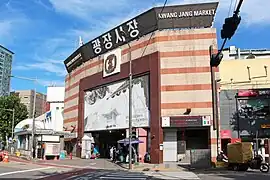  Exterior and interior of market | |
| General information | |
| Address | 88 Changgyeonggung-ro |
| Town or city | Jongno District, Seoul |
| Country | South Korea |
| Coordinates | 37°34′12″N 126°59′56″E / 37.570°N 126.999°E |
| Technical details | |
| Floor area | 42,000 m2 (450,000 sq ft) |
| Other information | |
| Number of stores | 5,000 |
| Public transit access | |
| Website | |
| www | |
| Korean name | |
| Hangul | 광장시장 |
| Hanja | |
| Revised Romanization | Gwangjang Sijang |
| McCune–Reischauer | Kwangjang sichang |
Gwangjang Market (Korean: 광장시장), previously Dongdaemun Market (동대문시장), is a traditional street market in Jongno-gu, Seoul, South Korea. The market is one of the oldest and largest traditional markets in South Korea, with more than 5000 shops and 20,000 employees in an area of 42,000 m2 (450,000 sq ft). Approximately 65,000 people visit the market each day.[1][2]
History
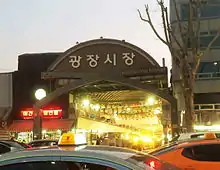
The Gabo Reforms, which were introduced during the Joseon dynasty, eliminated the merchant monopolies that existed in Joseon at the time by allowing anyone to engage in commercial activities.[2] The licensed merchants and shop owners in Seoul lost much of their business to competition as a result of these reforms, so King Gojong created a warehouse market called Changnaejang, which eventually developed into Namdaemun Market. After the signing of the Eulsa Treaty in 1905, when Korea was under Japanese colonial occupation, the Japanese took control of Namdaemun Market. In reaction to the seizure of Namdaemun Market, a group of private Korean investors, including wealthy merchants, decided to create a new market that was not under the control of the Japanese. They combined funds to create the Gwangjang Corporation on 5 July 1905, and purchased the land for the market with 100,000 Won.[1][3] They used the pre-existing Bae O Gae Market (배오개시장), a morning market in the area, as the foundation for their new market, which they named Dongdaemun Market (동대문시장).[4] At the time, most markets were temporary and open only occasionally, so Dongdaemun Market became the first permanent market to be open every day of the week.[3] The market was renamed Gwangjang Market in 1960.[5]
Name
Gwangjang Market was originally the name of a single, 3,000-pyeong (9,900 m2) shopping center in the center of Dongdaemun Market, which was built between 1957 and 1959. The name comes from the two bridges it was built between: Gwangkyo (광교; meaning "wide bridge") and Jangkyo (장교; meaning "long bridge").[1][4][5]
Products
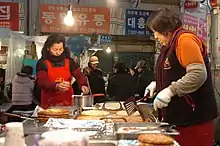
In the early years the market only sold agricultural and seafood products, but as it became one of the largest markets in Korea, it began to sell many other products. Today the market has approximately 1500–2000 vendors selling fruit, vegetables, meat, fish, bread, clothing, textiles, handicrafts, kitchenware, souvenirs, and Korean traditional medicinal items.[2] There are also many restaurants and food stalls selling traditional Korean cuisine, but the market is most famous for its bindaetteok, or mung bean pancakes, and mayak gimbap.[1][6][7]
Location
The market is accessible from Jongno 5-ga or Euljiro 4-ga metro station.[8]
In popular culture
- A 2014 episode of Running Man was partially filmed in the market.[6] The cast stopped at various food stalls and had to choose the correct card after finishing their food to continue the race.[9][10]
- The premiere of The Amazing Race Australia 4 featured a 'Detour' task at the market in which teams that chose this task had to roll, fill, and fold 50 dumplings.[11]
- Gwangjang Market and its street foods (Kal-guksu, Gejang and Bindae-tteok) were featured on the Netflix TV series, Street Food (TV series) in the Seoul, South Korea episode.[12]
Gallery
.jpg.webp) Mung beans being ground to make bindaetteok
Mung beans being ground to make bindaetteok Vendors frying bindaetteok
Vendors frying bindaetteok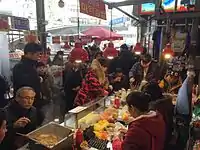 Vendors making mayak kimbap
Vendors making mayak kimbap Interior of the restaurant area of Gwangjang Market
Interior of the restaurant area of Gwangjang Market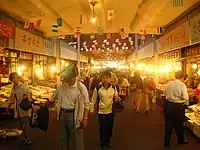 Interior of a fish market in Gwangjang Market
Interior of a fish market in Gwangjang Market
See also
References
- 1 2 3 4 Yun Suh-young (14 February 2013). "Gwangjang Market: Seoul's quirky foodie paradise". The Korea Times. Retrieved 25 February 2015.
- 1 2 3 Choi, Won-hyeong (21 July 2012). "Taste of Humanism in the 107-Year-Old Memories of Gwangjang Market". Korea Focus. The Hankyoreh. Archived from the original on 18 May 2015. Retrieved 22 April 2015.
- 1 2 "Gwangjang Market". VisitSeoul. 16 July 2014. Archived from the original on 7 April 2015. Retrieved 22 April 2015.
- 1 2 Ch?Ng, S?ng-mo (2006). Markets: Traditional Korean Society. ISBN 9788973006991.
- 1 2 광장시장 연혁 [Gwangjang Market History]. kwangjangmarket (in Korean). Archived from the original on 8 August 2020. Retrieved 30 January 2015.
- 1 2 "Gateway to Korea, Gwangjang Market entertains all five senses". 17 April 2014. Retrieved 21 April 2015.
- ↑ 광장시장 '빈대떡 대통령', 노점 음식의 공식을 새로 쓰다 [Gwangjang Market "The President of Bindaetteok", Opens New Official Food Stalls]. No Cut News (in Korean). 3 November 2014. Retrieved 28 January 2015.
- ↑ Shim Hyun-chul (21 June 2007). "Gwangjang Market". The Korea Times. Retrieved 25 February 2015.
- ↑ gummimochi (28 February 2014). "Running Man: Episode 186". Dramabeans. Retrieved 24 April 2015.
- ↑ I (이), Jae-won (재원) (23 February 2014). '런닝맨' 심은경, 광장시장 먹방서 '폭풍흡입' [Running Man's Shim Eun-kyung, Gwangjang Market "Meokbang" Stuffing Like a Storm]. 머니투데이 [Money Today] (in Korean). Retrieved 24 April 2015.
- ↑ "RECAP Gen Z siblings, Alana and Niko eliminated from THE AMAZING RACE AUSTRALIA". TV Blackbox. 28 October 2019. Retrieved 11 January 2020.
- ↑ "Cho Yonsoon's Korean Handmade Noodle Stall in Gwangjang Market: Featured on Netflix "Street Food"". KoreaTravelPost. KoreaTravelPost. Retrieved 30 March 2021.